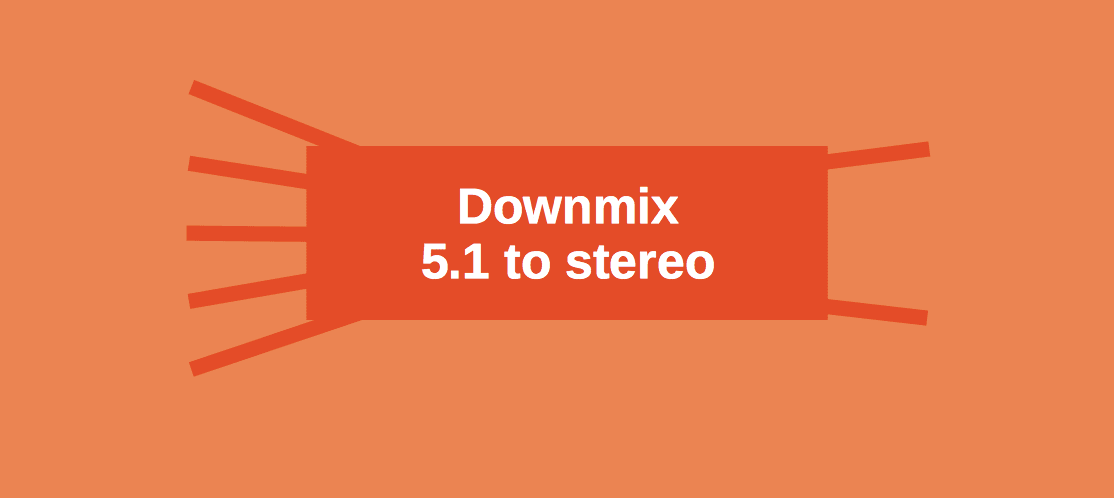
Downmixing 5.1, 5.0 to stereo is used to playback multichannel audio files at stereo systems. As rule, stereo headphones are used for music listening on portable audio players and mobile phones. Read how to convert multichannel to stereo to reduce music file size for limited disk-drive space of portable audio player or another device.

How to convert 5.1 audio to 2.0
To downmix 5.1 to stereo or 5.0 to 2.0 with high sound quality:
- Launch 5.1 to stereo converter software AuI ConverteR 48x44.
- Open multichannel audio file(s): SACD ISO (.iso), DSF, DFF, WAV, FLAC, AIFF, etc. to stereo DSF, WAV, FLAC, AIFF, etc. (check the channel-conversion-capable configurations).
- In the main window, select the target directory in Directory output files field.
- Click Tools button.
- In Tools window click Downmix tab.
- To conversion of channel number check Downmix to stereo switch. To keep original channel number uncheck the switch.
- Select mixing mode (see details below).
5.1 to stereo downmix levels are adjusted automatically. - Click OK button.
- Select target file format, sample rate, bit depth.
- Select directory for output files.
- Click Start button and wait the end of conversion.
WARNING:
DVD-audio/video, Blu-Ray, DVD/BluRay/CD ISO are NOT supported.
For Modula-R version, SACD ISO, DSF, DFF are supported in proper configurations.
For ISO tracks, DSF, DFF longer than 3 minutes, FREE edition mutes 2-second silence in the output middle and has other restrictions. In batch conversion FREE version mutes 2 seconds in the output middle for second and the subsequent files.
Free version has processing sound quality identical commercial editions.

Sound quality
Channel number reduction is not a purely technical procedure. How to downmix 5.1 to stereo is an element of art.
Played multichannel record back may have a different sound depending on the listening room and apparatus with its settings.
When studio producers have original mono tracks for each sound source of the record, their spatial locations can be modeled mathematically. The calculation may be done for a given channel number N. In instance, N=6 or 5.1 or five speakers and subwoofer. As result, we get several N-channel tracks. They are united into a single N-channel bus. And, N-channel recording is distributed.
5.1-to-stereo converter or downmix plugin of digital audio workstation has this distributed record as input. So there are issues with the sound source separation. And channel number conversion is not the same as the above-mentioned studio work, where sources may be separated.
Studio records may be provided in several variants with the different channel number. As example, multichannel and 2.0 options of the same album.
It is not possible to say what is better in the general case: stereo variant of studio record or multichannel file, that is downmixed in conversion software. There are many conditions: original stuff, quality of math modeling, converter's algorithm, others. In the author's opinion, the best thing to do is compare target stereo records aurally.
Downmix processing may not be bit-perfect even theoretically. It changes audio signal in any option.
Qualitative downmix introduces low distortions.
Audio channel converter settings
Above we considered that no single "right" way to convert 5.1 audio to 2 channel file.
Therefore AuI ConverteR provides 2 alternative downmixing modes:
- Mode 0 : artificial easy spatial expansion is applied.
- Mode 1 : more spatial processing is applied.
- Mode 2 : minimalistic processing is applied (developers consider it more "natural").
Depending on the converter version number, various modes may be supprorted.

You may select the mode which the sound you prefer.
Back to topCheck software configuration to downmix 5.1/5.0 to stereo
You can check the sound of the downmix processing in FREE edition when converting 5.1 to stereo.
For Modula-R edition the option of 5.1 to 2.0 converter is applied in the "Downmix (add-on)" module. It may be purchased separately. "Base (core)" module is required for this add-on.
SACD ISO-capable configurations of AuI ConverteR allow extracting either stereo tracks from SACD ISO or getting multichannel tracks with downmixing 5.1 to stereo files.
AuI ConverteR is a configurable software that lets you choose the features you need and pay only for them. A "module" is a part of AuI ConverteR's functionality that you can buy separately. You can buy new modules later to enhance your Modula-R major version (details). Each module is a license key that you get by email and enter in the software. A "major update" is a change in the first version number of the software version (for example, from 10.x to 11.x) and it is not free. However, your license is unlimited-time, which means you can use the software as long as you want without any subscription fees. (details)
IMPORTANT: The Free version of AuI ConverteR does not work with any modules. You need to buy a CORE module first, and then you can add other modules that are compatible with it (details). If you buy all the modules, you get the same features as the PROduce-RD version, which is a complete and cheaper package. You cannot exchange your Modula-R license for a PROduce-RD license.
* All prices on this page are in U.S. dollars without V.A.T. and other applicable taxes and fees. The prices are recommended. Information on this page is not a public offer.
Back to top
Frequently Asked Questions
How do I switch from 5.1 to stereo?
You can switch 5.1 to stereo this way...
What happens if you play 5.1 on stereo?
Stereo and multichannel audio is designed for spatial positioning of sound source. If you play 5.1 on a stereo device, 6 channels of source file are downmixed to 2 one. The positioning abilities are reduced.
There are many ways how to downmix. But, there is no scientifically exact way to convert 5.1 audio to stereo.
Read about spatial positioning in home audio here...
Is downmix 5.1 to 2.0 lossless?
Downmix may not be lossless in any case. Because original information is transformed.
Back to top